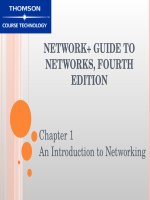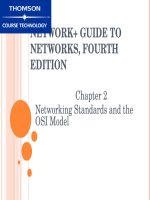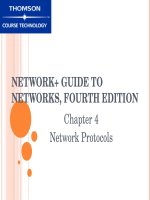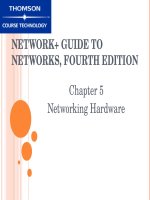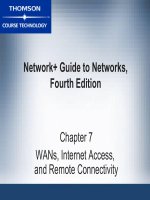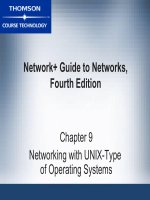NETWORK+ GUIDE TO NETWORKS, FOURTH EDITION - CHAPTER 2 ppt
Bạn đang xem bản rút gọn của tài liệu. Xem và tải ngay bản đầy đủ của tài liệu tại đây (664.82 KB, 43 trang )
NETWORK+ GUIDE TO
NETWORKS, FOURTH
EDITION
Chapter 2
Networking Standards and the
OSI Model
OBJECTIVES
Identify organizations that set standards for
networking.
Describe the purpose of the OSI Model and each of
its layers
Explain specific functions belonging to each OSI
Model layer
Network+ Guide to Networks, 4e
2
OBJECTIVES (CONTINUED)
Understand how two network nodes
communicate through the OSI model
Discuss the structure and purpose of data
packets and frames.
Describe the two types of addressing covered by
the OSI Model.
Network+ Guide to Networks, 4e
3
NETWORKING STANDARDS
ORGANIZATIONS
ANSI
American National Standards Institute (ANSI)
Composed of more than a thousand representatives
from industry and government
Represents United States in setting international
standards
Network+ Guide to Networks, 4e
ANSI standards documents available:
ANSI’s Web site (www.ansi.org)
At university or public libraries
4
EIA AND TIA
Electronic Industries Alliance (EIA): Trade
organization composed of representatives from
electronics manufacturing firms across US
Sets standards for its members
Helps write ANSI standards
Lobbies for legislation favorable to growth of computer
and electronics industries
Network+ Guide to Networks, 4e
Telecommunications Industry Association (TIA):
Focuses on standards for information technology (IT),
wireless, satellite, fiber optics, and telephone.
5
IEEE
Institute of Electrical and Electronics Engineers
International society composed of engineering
Goals are to promote development and education in
electrical engineering and computer science.
IEEE technical papers and standards are highly
respected in the networking profession
Can purchase IEEE documents online from IEEE’s Web site
(www.ieee.org)
6
Network+ Guide to Networks, 4e
ISO
International Organization for Standardization
Network+ Guide to Networks, 4e
Collection of organization standards representing 146
countries
Goal is to establish international technological
standards to facilitate global exchange of
information and barrier-free trade
Fewer than 300 of ISO’s more than 14,250 standards
apply to computer-related products and functions.
7
ITU
International Telecommunication Union
Regulates international telecommunications:
Radio and TV frequencies
Satellite and telephony specifications
Networking infrastructure
Tariffs applied to global communications
Typically, documents pertain more to global
telecommunications issues than to industry technical
specifications .
8
Network+ Guide to Networks, 4e
ISOC
Internet Society
Professional membership society that helps to
establish technical standards for the Internet
Oversees groups with specific missions
Internet Architecture Board (IAB) : Technical advisory
group of researchers and professionals.
Interested in overseeing Internet’s design and
management
Internet Engineering Task Force (IETF): Sets standards for
how systems communicate over the Internet
How protocols operate and interact
9
Network+ Guide to Networks, 4e
IANA AND ICANN
Internet Assigned Numbers Authority (IANA):
Used to keep records of available and reserved IP
addresses and determines how addresses were
doled out.
In 1997, coordinated efforts with three Regional
Internet Registries (RIRs)
Not-for-profit agency that manages distribution of IP
addresses to private and public entities.
10
Network+ Guide to Networks, 4e
THE OSI MODEL
Physical, Data Link, Network, Transport, Session,
Presentation, and Application
Protocols perform services unique to layer
Protocols interact with protocols in layers directly
above and below
Protocol: set of instructions to perform a function
or group of functions
Written by a programmer
11
Network+ Guide to Networks, 4e
Open Systems Interconnection (OSI) Model:
divides network communications into seven
layers:
THE OSI MODEL (CONTINUED)
Theoretical representation of what happens
between two nodes communicating on a network
Does not prescribe type of hardware or software that
should support each layer
Does not describe how software programs interact
with other software programs or how software
programs interact with humans
Network+ Guide to Networks, 4e
Each layer communicates with same layer from
one computer to another
Model is imperfect(khơng hồn hảo)
12
THE OSI MODEL (CONTINUED)
Network+ Guide to Networks, 4e
Figure 2-1: Flow of data through the OSI Model
13
APPLICATION LAYER
Services facilitate communication between
software and lower-layer network services
Hypertext Transfer Protocol (HTTP): formats and
sends requests from client’s browser to server
Helps software applications negotiate formatting,
procedural, security, synchronization, and other
requirements with network
Also formats and sends Web server’s response back
to client’s browser
Application program interface (API): set of
routines that make up part of a software
application
14
Network+ Guide to Networks, 4e
PRESENTATION LAYER
Protocols accept Application layer data and
format it
So that one type of application and host can
understand data from another type of application and
host
e.g., translation and conversion between graphics file types
Manages data encryption and decryption
15
Network+ Guide to Networks, 4e
SESSION LAYER
Protocols coordinate and maintain
communications between two network nodes
Network+ Guide to Networks, 4e
Establish and maintain communications link for
duration of session
Keep communication secure
Synchronize dialogue between two nodes
Determine if communications have been cut off
Determine where to restart transmission
Terminate communications
16
SESSION LAYER (CONTINUED)
Sets terms of communication
Decides which node will communicate first
Decides how long a node can communicate
Network+ Guide to Networks, 4e
Monitors identification of session participants
Ensures that only authorized nodes have access
17
TRANSPORT LAYER
Protocols accept data from Session layer and
manage end-to-end delivery of data
Protocols also handle flow control
Ensure data transferred reliably, in correct sequence,
and without errors
Gauging appropriate rate of transmission based on
how fast recipient can accept data
Transmission Control Protocol (TCP): Takes care of
reliably transmitting HTTP requests from client to
server and vice versa
18
Network+ Guide to Networks, 4e
TRANSPORT LAYER (CONTINUED)
Connection-oriented protocols: ensure that data
arrives exactly as it was sent
Network+ Guide to Networks, 4e
Establish connection before transmitting data
TCP is connection-oriented
Client’s TCP protocol first sends synchronization (SYN)
packet request to server
Server responds with synchronization-acknowledgment
(SYN-ACK) packet
Client responds with own acknowledgment (ACK)
19
TRANSPORT LAYER (CONTINUED)
Acknowledgments also used to ensure that data
was properly delivered
For every data unit sent, connection-oriented
protocol expects acknowledgment from recipient
If no acknowledgment, data retransmitted
Connection-oriented protocols use a checksum
Unique character string allowing receiving node to
determine if arriving data unit exactly matches data
unit sent by source
20
Network+ Guide to Networks, 4e
TRANSPORT LAYER (CONTINUED)
Connectionless protocols do not establish
connection before transmitting
Network+ Guide to Networks, 4e
No effort to ensure data delivered error-free
Transport layer protocols break large data units
received from Session layer into smaller
segments (segmentation)
Maximum transmission unit (MTU): largest data
unit a given network will carry
21
TRANSPORT LAYER (CONTINUED)
Reassembly: process of reconstructing
segmented data units
Sequencing: method of identifying segments that
belong to same group of subdivided data
22
Network+ Guide to Networks, 4e
Indicates where unit of data begins
Indicates order in which groups of data were issued
Transport layer protocols of two nodes must
synchronize timing and agree on starting point for
the transmission
TRANSPORT LAYER (CONTINUED)
Network+ Guide to Networks, 4e
Figure 2-2: Segmentation and Reassembly
23
TRANSPORT LAYER (CONTINUED)
Network+ Guide to Networks, 4e
Figure 2-3: A TCP segment
24
NETWORK LAYER
Primary functions of protocols:
Translate network addresses into physical
counterparts
Decide how to route data from sender to receiver
Network+ Guide to Networks, 4e
Each node has two types of addresses:
Network address: follows hierarchical addressing
scheme
Can be assigned through OS software
Network layer addresses, logical addresses, or virtual
addresses
Physical address
25

